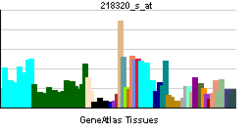- NDUFB11
-
NADH dehydrogenase (ubiquinone) 1 beta subcomplex, 11, 17.3kDa Identifiers Symbols NDUFB11; ESSS; FLJ20494; MGC111182; NP17.3; Np15; P17.3 External IDs OMIM: 300403 MGI: 1349919 HomoloGene: 10398 GeneCards: NDUFB11 Gene Gene Ontology Molecular function • NADH dehydrogenase activity
• NADH dehydrogenase (ubiquinone) activity
• oxidoreductase activityCellular component • mitochondrion
• mitochondrial inner membrane
• mitochondrial respiratory chain complex I
• membrane
• integral to membrane
• respiratory chainBiological process • transport
• respiratory electron transport chainSources: Amigo / QuickGO RNA expression pattern 
More reference expression data Orthologs Species Human Mouse Entrez 54539 104130 Ensembl ENSG00000147123 ENSMUSG00000031059 UniProt Q9NX14 Q4VBC9 RefSeq (mRNA) NM_001135998.1 NM_019435.4 RefSeq (protein) NP_001129470.1 NP_062308.2 Location (UCSC) Chr X:
47 – 47 MbChr X:
20.19 – 20.19 MbPubMed search [1] [2] ESSS subunit of NADH:ubiquinone oxidoreductase (complex I) Identifiers Symbol ESSS Pfam PF10183 InterPro IPR019329 Available protein structures: Pfam structures PDB RCSB PDB; PDBe PDBsum structure summary NADH dehydrogenase [ubiquinone] 1 beta subcomplex subunit 11, mitochondrial (NADH-ubiquinone oxidoreductase ESSS subunit) is an enzyme that in humans is encoded by the NDUFB11 gene.[1][2][3]
References
- ^ Cui Y, Yu L, Gong R, Zhang M, Fan Y, Yue P, Zhao S (Nov 1999). "Cloning and tissue expressional characterization of a full-length cDNA encoding human neuronal protein P17.3". Biochem Genet 37 (5–6): 175–85. doi:10.1023/A:1018734605214. PMID 10544803.
- ^ Carroll J, Shannon RJ, Fearnley IM, Walker JE, Hirst J (Dec 2002). "Definition of the nuclear encoded protein composition of bovine heart mitochondrial complex I. Identification of two new subunits". J Biol Chem 277 (52): 50311–7. doi:10.1074/jbc.M209166200. PMID 12381726.
- ^ "Entrez Gene: NDUFB11 NADH dehydrogenase (ubiquinone) 1 beta subcomplex, 11, 17.3kDa". http://www.ncbi.nlm.nih.gov/sites/entrez?Db=gene&Cmd=ShowDetailView&TermToSearch=54539.
Further reading
- Petruzzella V, Tessa A, Torraco A, et al. (2007). "The NDUFB11 gene is not a modifier in Leber hereditary optic neuropathy". Biochem. Biophys. Res. Commun. 355 (1): 181–7. doi:10.1016/j.bbrc.2007.01.140. PMID 17292333.
- Ross MT, Grafham DV, Coffey AJ, et al. (2005). "The DNA sequence of the human X chromosome". Nature 434 (7031): 325–37. doi:10.1038/nature03440. PMC 2665286. PMID 15772651. http://www.pubmedcentral.nih.gov/articlerender.fcgi?tool=pmcentrez&artid=2665286.
- Gerhard DS, Wagner L, Feingold EA, et al. (2004). "The Status, Quality, and Expansion of the NIH Full-Length cDNA Project: The Mammalian Gene Collection (MGC)". Genome Res. 14 (10B): 2121–7. doi:10.1101/gr.2596504. PMC 528928. PMID 15489334. http://www.pubmedcentral.nih.gov/articlerender.fcgi?tool=pmcentrez&artid=528928.
- Ota T, Suzuki Y, Nishikawa T, et al. (2004). "Complete sequencing and characterization of 21,243 full-length human cDNAs". Nat. Genet. 36 (1): 40–5. doi:10.1038/ng1285. PMID 14702039.
- Clark HF, Gurney AL, Abaya E, et al. (2003). "The Secreted Protein Discovery Initiative (SPDI), a Large-Scale Effort to Identify Novel Human Secreted and Transmembrane Proteins: A Bioinformatics Assessment". Genome Res. 13 (10): 2265–70. doi:10.1101/gr.1293003. PMC 403697. PMID 12975309. http://www.pubmedcentral.nih.gov/articlerender.fcgi?tool=pmcentrez&artid=403697.
- Strausberg RL, Feingold EA, Grouse LH, et al. (2003). "Generation and initial analysis of more than 15,000 full-length human and mouse cDNA sequences". Proc. Natl. Acad. Sci. U.S.A. 99 (26): 16899–903. doi:10.1073/pnas.242603899. PMC 139241. PMID 12477932. http://www.pubmedcentral.nih.gov/articlerender.fcgi?tool=pmcentrez&artid=139241.
Categories:- Human proteins
- Chromosome X gene stubs
Wikimedia Foundation. 2010.
